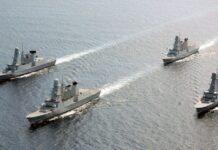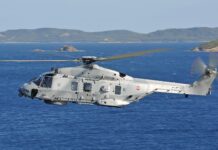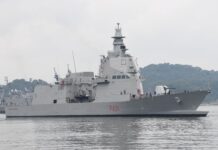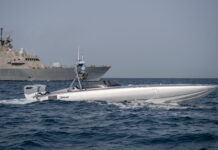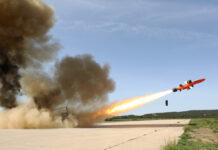Investment in naval surface-to-surface guided weapons (SSGWs) has fallen behind since the end of the Cold War but recent projects aim to modernise missile capabilities and adapt them for the emerging operational environment. Meanwhile naval gun systems are also proving to offer a useful all-round multi-mission fire support and air defence capability for warships, being able to engage a wide variety of targets. This article explores the latest developments.
An evolving environment
The two main surface-to-surface anti-ship missiles (ASMs) that occupy the inventories of most ‘western’ naval forces are the US-built Harpoon and the French-made Exocet, both of which were first developed in the 1970s. These weapons were designed for securing the sea lanes of communications across the oceans and optimised for striking targets in a ‘blue water’ environment with sea-skimming and ‘fire-and-forget’ capabilities.
However, current naval operations are increasingly being focussed towards the ‘green water’ littoral environment, which is very different to the open sea. The cluttered environment and presence of more pervasive sensor systems mean that missiles need to be ‘smarter’, with an ability to find targets in the cluttered coastal environment and overcome ship defences that might include advanced electronic warfare jamming, decoys, gun and missile defences, and even uncrewed systems. Modern missiles may also need to have the capability to attack targets at extended ranges, use tactical waypoints, conduct course changes, maintain two-way communications, have options for target selection, and hit targets on land with more precision.
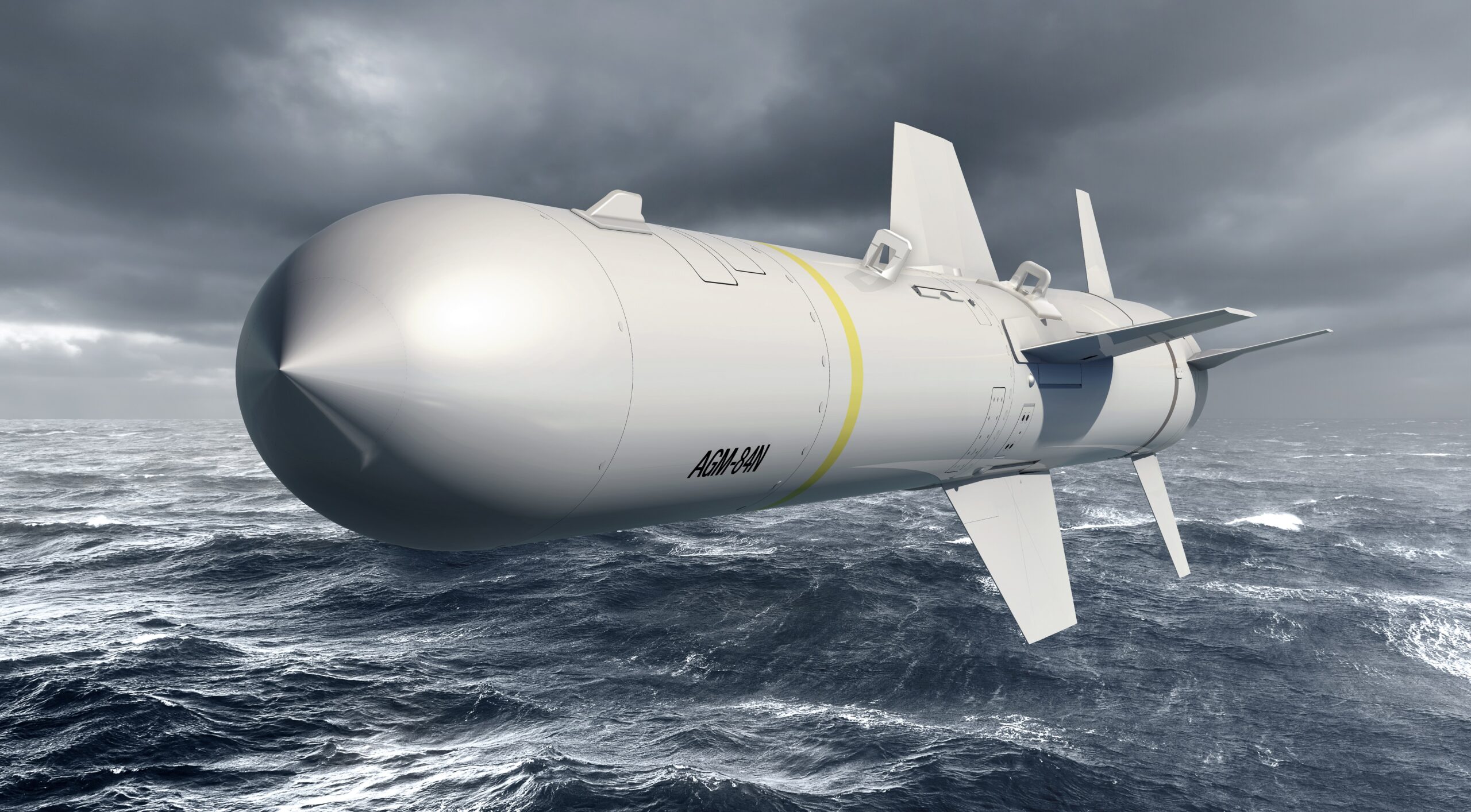
Credit: US Navy
ASM veterans stay relevant
Despite the changing operational environment, the Boeing Harpoon ASM remains one of the most widely-used anti-ship missiles in the world; currently being in service with over 30 countries. First introduced in 1977, Harpoon’s older variants have become increasingly obsolete and vulnerable to jamming; a weakness that is being addressed through production of the latest RGM-84Q-4 Harpoon Block II Plus (+) Extended Range (ER) iteration that is being acquired by the US Navy as an upgrade package. In addition to incorporating a lighter but more lethal warhead that extends missile range to over 200 km by providing more space for fuel, this variant incorporates improved guidance technologies and data links that were not available when older Harpoon ASMs first entered service. Improved targeting information will allow the Harpoon Block II+ ER to find enemy warships hiding along coastal areas where there could be high levels of commercial shipping more easily.
Meanwhile, MBDA also continues to modernise Exocet, the other widely used ‘western’ ASM. Its latest variant is the MM40 Block 3C, which includes a new ‘coherent’ active RF seeker from Thales and a digital radio altimeter. These enhancements build on the extended, 200 km range introduced with the previous, turbo-jet powered MM40 Block 3 iteration, which also implemented GPS-based guidance and thereby provided a limited ground-attack capability. The French Navy completed an operational evaluation of the Block 3C missile from the French Navy’s Aquitaine class frigate FS Alsace in September 2023, following on from MBDA’s commencement of deliveries of the first Block 3C missiles to the French DGA procurement agency in January 2022. So far the French Navy has ordered 95 new missiles and 45 upgrade kits for the MM40 Block 3. Greece has also ordered the Block 3C as MBDA’s first export customer.
New SSGW entrants
Whilst Harpoon and Exocet remain very popular, other new ASM options have entered the market to address the challenges specific to modern maritime warfare in the littorals. Of these, the Naval Strike Missile (NSM) produced by Norway’s Kongsberg is undoubtedly the most significant. In service with the Royal Norwegian Navy since 2012, it has recently seen huge increase in sales as navies worldwide seek to increase their ASM inventories and add new capabilities to penetrate sophisticated ship defences. In many cases, NSM is acting as a replacement for older Harpoon variants.
With a range in excess of 200km, the NSM is designed to be low-observable, with a small radar cross section and a low sea-skimming height. It is subsonic, with a design focussed on high manoeuvrability and stealth to attack a target instead of trying to overcome ship defences through speed. The NSM is fitted with an anti-jamming GPS mid-course guidance system and a dual band imaging infra-red (IIR) seeker with automatic target recognition. The IIR seeker allows the NSM to search for surface ship targets in the terminal phase passively. Most other existing ASMs use an active radar to find enemy ships but this means they emit a RF signal that can be detected and thus allow countermeasures to be deployed against them. Whilst an IIR seeker can be susceptible to bad weather blocking it from receiving signals, Kongsberg argues that these scenarios are rare and are outweighed by the benefits of stealth. The IIR also offers a land-attack capability.
To date, the NSM has been sold to over a dozen fleets, including such ‘heavy hitters’ as the US Navy, British Royal Navy and Royal Australian Navy (RAN). The missile is being installed aboard American littoral combat ships and future Constellation (FFG-62) class frigates, with some Royal Navy Type 45 destroyers and Type 23 frigates also being equipped to provide an interim ASM capability prior to development of the Anglo-French Future Cruise/Anti-Ship Weapon (FC/ASW). On 22 July 2024, the RAN Hobart class destroyer Sydney completed Australia’s first NSM test firing, paving the way for its use across the country’s surface fleet. The NSM is currently available in surface and air (Joint Strike Missile) iterations, whilst a submarine-launched version is under development. A joint programme with Germany for a future SuperSonic Strike Missile (3SM) ‘Tyrfing’ is also in its early stages.

Credit: BAE Systems
Meanwhile, Norway’s Scandinavian neighbour, Sweden, is pursuing a separate course by developing the RBS15 Mk 4 ‘Gungnir’ ASM. Built by Saab, the Mk 4 is a further development of the RBS Mk 2 and Mk 3 missiles and has a similar missile body to the latter. However, it uses a composite airframe and miniaturised internal components to reduce weight. This permits an increased fuel payload that gives the Mk 4 a range in excess of 300 km. The Mk 4 will be fitted with a Ku-band active radar seeker, anti-jamming GPS, and electronic counter countermeasures (ECCM). It retains some other key features from the Mk 3, including a low (under 3 m) sea-skimming capability and a land attack capacity.
Saab was awarded a contract for the Mk4 variant in 2017. It is due to enter service in the mid-2020s and will encompass both sea-launched and air-launched variants. The Royal Swedish Navy considers that Harpoon and many other current ASM types are optimised to provide a ‘blue water’ capability whereas it needs a missile optimised for hitting targets in the Baltic Sea. This is the reason behind the use of an active seeker, as it ensures an all-weather capability. Future options for the Mk 4 include a two-way data link and an additional seeker; either an EO/IR camera or semi-active laser.
Amongst other new missiles under development is the new Brazilian MANSUP (‘Míssil Antinavio Nacional de Superfície’) ASM. MANSUP will provide an all-weather, sea-skimming ASM with mid-range capability for the Brazilian Navy, replacing the Exocet MM40 Block 1 that is currently in service. Development work should be completed by 2025, in time for it to be installed on the new MEKO series Tamandaré class frigates. Another significant programme is Turkey’s ATMACA ASM, which is being produced by Roketsan for the Turkish Naval Forces as an indigenous replacement for the Harpoon. Its guidance system incorporates inertial navigation and GPS guidance, with an active radar seeker being used for final targeting. Reported range is over 220 km. Achieving initial operating capability in 2021, ATMACA is subject to ongoing development that includes use of an indigenous turbo-jet and provision of an (alternative) IIR seeker.
Looking ahead, new capabilities for anti-ship missiles likely include advanced counter-countermeasures and a collaborative tactical capability with other missiles or effectors.
Gun power pushes the boundaries
Meanwhile, naval guns remain a critical piece of a warship’s weapons’ outfit that are well suited to littoral operations. Their ability to offer a cost-effective means of providing sustained high-rates of fire using large stores of ammunition that can be easily replenished whilst at sea is a particularly valuable capability for naval forces. Medium calibre naval guns are now largely produced in 127 mm (5 in) and 76 mm (3 in) categories, being supplemented by a wide variety of lighter weapons.

Credit: Kongsberg
Naval guns can engage targets on land, sea and in the air. In the last-mentioned domain, they are particularly valuable in providing defence against uncrewed aerial threats. Here, their use is more cost-effective than using a limited supply of expensive missiles, which also need to be preserved for engaging more dangerous threats at longer distances. This has been particularly demonstrated during recent naval operations off the coast of Yemen. For example, in July 2024, the Hellenic Navy’s Hydra class (MEKO 200) frigate, HS Psara, reportedly used its 5 in (127 mm) Mk 45 Mod 2A naval gun to shoot down two drones launched by the Houthi rebels.
Guided munitions are also extending the range of naval gunfire capability, so that gunfire support can be conducted at longer distances. Ships equipped with 127 mm guns usually require a substantial displacement to manage recoil forces and accommodate the weight of the ammunition magazines and handling devices. This means these types of gun systems are typically reserved for destroyers and frigates. Other calibres such as 76 mm naval guns can be deployed aboard smaller warships, including corvettes, patrol vessels and fast attack craft.
Current 127 mm naval gun systems
The two most common 127 mm (5 in) naval gun systems in use around the world today are the US Mk 45 5 in mounting manufactured by BAE Systems and the equivalent 127 mm naval mount produced by Italy’s Leonardo.
Variants of the BAE Systems’ Mk 45 gun are in service aboard warships from Australia, Denmark, Greece, Japan, New Zealand, South Korea, Taiwan, Thailand and Turkey in addition to the United States. Its latest iteration is the Mk 45 Mod 4A. The Mod 4 was developed to allow the mounting to fire ammunition at longer ranges than previous iterations, as well as facilitating the possible future use if precision-guided munitions (PGMs) The Mod 4 configuration includes the addition of a longer, 62 calibre barrel (compared with the previous 54 calibre), a strengthened gun mount and an advanced control system that allows the engagement of a wider range of threats, including small drones. It also encompasses changes to the mounting’s shape to reduce its radar signature.

The potential use of PGMs in conjunction with the Mk 45 Mod 4 would, for example, mean that fewer rounds would be needed to hit a target, extending the time for which a ship could provide fire support. BAE Systems has been developing a Hypervelocity Projectile (HVP) for both the Mk 45 and heavier calibre US Army 155 mm guns that has also demonstrated counter-UAV and missile defence capabilities in addition to extremely long-range precision fire. Speaking about the HVP, Tate Westbook, Business Development Director, Naval Guns and Missile Launchers at BAE Systems told ESD: “Its manoeuvrability, paired with its high velocity and ability for precision guidance, allows it to engage air threats with minimum response time. With new low-cost air threats that are deployed in swarms, this munition provides an advance layer of protection for the surface fleet.”
The Mk45 Mod 4A gun also includes provision for an automated Ammunition Handling System (AHS) that can resupply the gun whilst firing and ensures it can continue firing, whilst also removing the sailors from the most dangerous part of the reloading process. The AHS is being provided to the British Royal Navy and RAN as part of their contracts with BAE Systems to provide Mk 45 Mod 4A mountings for, respectively, their Type 26 and Hunter class frigates.
The equivalent, most recent Leonardo OTO 127/64 LW (lightweight) medium calibre mounting can already fire guided munitions in the form of Vulcano ammunition that was developed in partnership with Diehl. Vulcano ammunition is available in Ballistic Extended Range (BER) and Guided Long Range (GLR) variants. These are fitted with different multifunctional fuses, sensors and final guidance components that can extend the range of the gun up to 100 km. The gun can also fire a full range of standard 127 mm ammunition.
Other elements of the OTO 127/64 LW Vulcano system include a fire control system and a modular AHS that can be adapted to various magazine layouts. The AHS loads a feeding magazine that comprises four drums of 14 ready-to-fire rounds that can be reloaded during firing.
The OTO 127/64 LW Vulcano system was first fitted to the Italian Navy’s general purpose Bergamini variant of the FREMM frigate design and is also being installed in the Paolo Thaon di Revel class multi-role combatants. It is also currently in Algerian, Egyptian and German service and has been ordered by Canada, the Netherlands and Spain.
OTO 76mm mounting
Leonardo also continues to produce various iterations of its 76/62 gun mounting that began life in the 1960s as the OTO Melara Compact. As previously noted, the 76 mm gun offers a lighter calibre system that can be fitted to many smaller vessels. However, it still offers powerful, multi-role capabilities that are assisted by the development of DART (Strales) and Vulcano guided munitions. According to Leonardo, a 76mm gun utilising DART ammunition and associated fire control has the capability to provide point defence against manoeuvring missiles with a similar effectiveness to a Very Short Range Air Defence (VSHORAD) missile. Alternatively, the use of Vulcano 76 mm rounds can allow engagements of shore targets in excess of 30 km with high levels of accuracy.
Leonardo is also evolving various mounting configurations for the 76mm gun. The latest is the ‘Sovraponte’ configuration, which stows its ammunition within the mounting’s body and thereby does not penetrate the ship’s structure. This increases installation options, such as a location on top of a ship’s helicopter. The ‘Sovraponte’ was first installed aboard the lead ship of the Paolo Thaon di Revel class, which commissioned in 2022.
Future developments in the naval gun and ammunition sector include new guided ammunition types with additional functionalities that incorporate emerging technologies. Reduction in weight is another area of focus. For example, the development of barrels using aluminium, titanium and composites could help reduce weight but keep structural resistance to the high stresses experienced when firing. Other areas of development include structural calculations (both static and dynamic), control engineering, ballistics, performance analysis, aerodynamics, AHS, and hardware and software management.
Conclusion
The modernisation of surface-to-surface guided missiles and the introduction of new ASM weapons show the renewed focus that is being placed on giving navies effective engagement capabilities in these areas, particularly when operating in littoral regions. New components and technologies will likely increase functionality, giving warships the ability to strike targets even in complex conditions.
Meanwhile the market for heavy calibre naval guns remains significant as naval forces continue to value their all-round utility for air, land and sea engagements. Indeed, this utility is only increasing with the development of new munition options and the need to find an effective defence against UAVs, which are becoming an increasing threat.
Tim Fish






